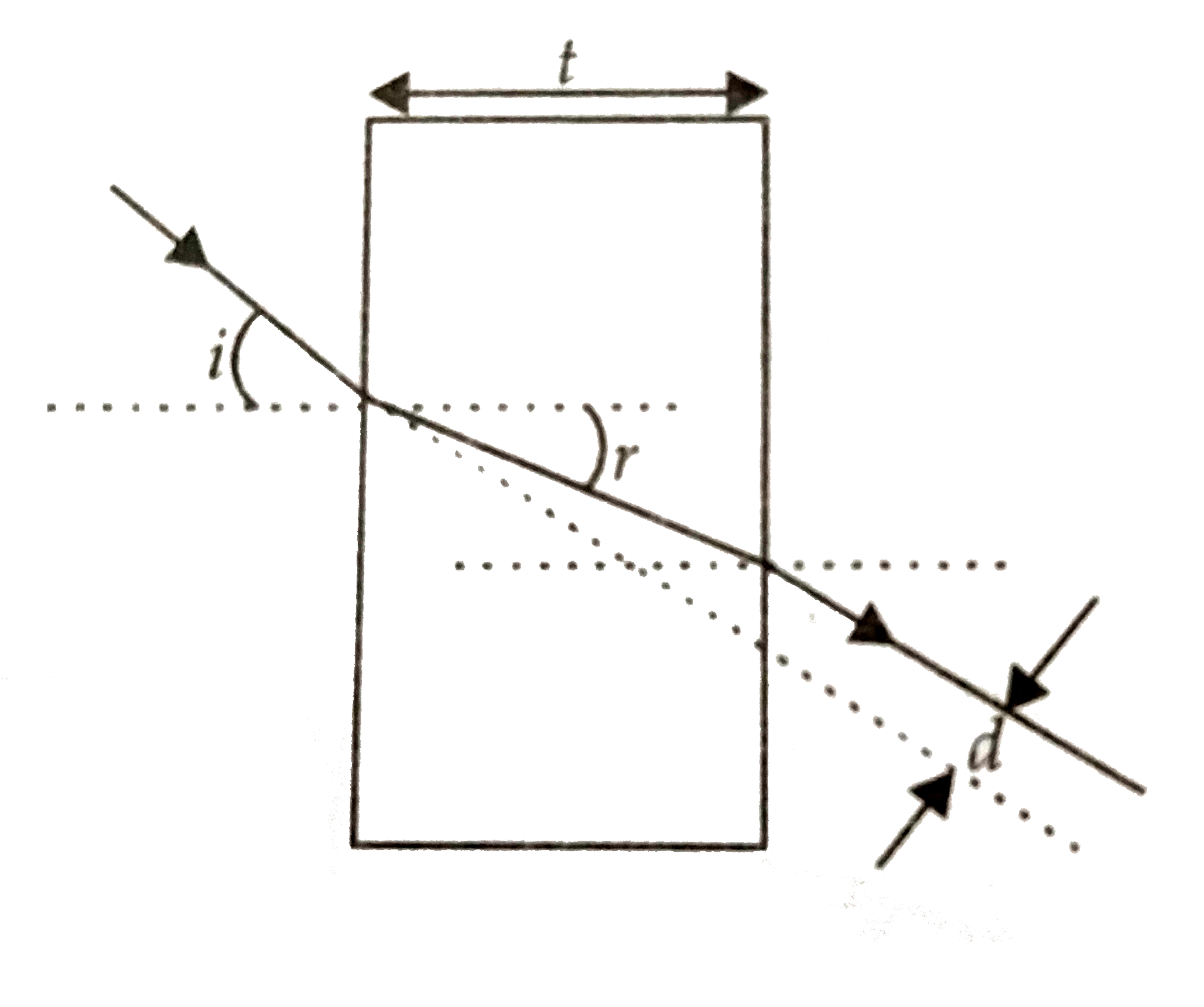A rays of light is incident on a thick slab of glass of thickness t as shown in figure. The emergent ray is parallel to the incident ray but displaced sideways by a distance d. If the angles are small then d is

t(1+ir)
rt(1−ir)
it(1−ri)
t(1+ri)
The correct Answer is:C
Lateral shift, d=tcosrsin(i−r)
For small angles sin(i−r)≈i−r, cosr≈1
d=t(i−r),d= it [1−ri]
Topper's Solved these Questions
- RAY OPTICS AND OPTICAL INSTRUMENTSBOOK - NCERT FINGERTIPSCHAPTER - RAY OPTICS AND OPTICAL INSTRUMENTSEXERCISE - Total Internal Reflection
7 Videos
- RAY OPTICS AND OPTICAL INSTRUMENTSBOOK - NCERT FINGERTIPSCHAPTER - RAY OPTICS AND OPTICAL INSTRUMENTSEXERCISE - Reflection At Spherical Surfaces And By Lenses
41 Videos
- RAY OPTICS AND OPTICAL INSTRUMENTSBOOK - NCERT FINGERTIPSCHAPTER - RAY OPTICS AND OPTICAL INSTRUMENTSEXERCISE - Assertion And Reason
15 Videos
- PRACTICE PAPPERBOOK - NCERT FINGERTIPSCHAPTER - PRACTICE PAPPEREXERCISE - Practice Paper 3
50 Videos
- SEMICONDUCTOR ELECTRONICS : MATERIALS , DEVICES AND SIMPLE CIRCUITS BOOK - NCERT FINGERTIPSCHAPTER - SEMICONDUCTOR ELECTRONICS : MATERIALS , DEVICES AND SIMPLE CIRCUITS EXERCISE - Assertion And Reason
15 Videos
Similar Questions
A light ray passes from air to denser medium of certain thickness and emerges on the other side. If emergent ray is parallel to the incident ray, the distance travelly by the ray of light in the denser medium is 6 cm, and the angle of incidence and refraction are 60∘and30∘ , respectively, find the lateral displacement of the light ray.
View SolutionWhen rays of light are incident on a glass slab, then the incident ray and emergent ray are ____ to each other.
View Solution
Knowledge Check
A ray of light strikes a glass slab of thickness t. It emergens on the opposite face, parallel to the incident ray but laterally displaced. The lateral displacement, Δx is
AΔx=0BΔx = t sin ( I - r) cos rCΔx=t sin Icos rDΔx= t sin ( I - r)cos rA ray of light is incident on the surface of a glass plate of thickness t. I fthe angle of incidence θ is small, the emerging ray would be displaced side ways by an amount
[Taken = refractive index of glass)Atθn/(n+1)Btθ(n−1)/nCtθn/(n−1)Dtθ(n+1)/nA ray of light is incident on the surface of a glass plate of thickness t. If the angle of incidence θ is small, the emerging ray would be displaced side ways by an amount
(Take n = refractive index of glass)Atθn/(n+1)Btθ(n−1)/nCtθn/(n−1)Dtθ(n+1)/n
A ray of light is incident perpendicularly on a glass slab. The angle of incidence is 900.
View SolutionMaximum lateral displacement of ray light incident on a slab of thickness t is
View SolutionA ray of light is incident on a parallel-sided glass slab as shown in the figure. The angle of refraction for this ray of light is likely to be :

View SolutionA ray of light is incident on a glass slab of thickness t, at an angle i,r is the angle of refraction in the glass slab. Distance travelled in the glass slab is
View SolutionWhen rays of light are incident on a glass slab, then the incident ray and emergent ray are ……….. To each other.
View Solution
